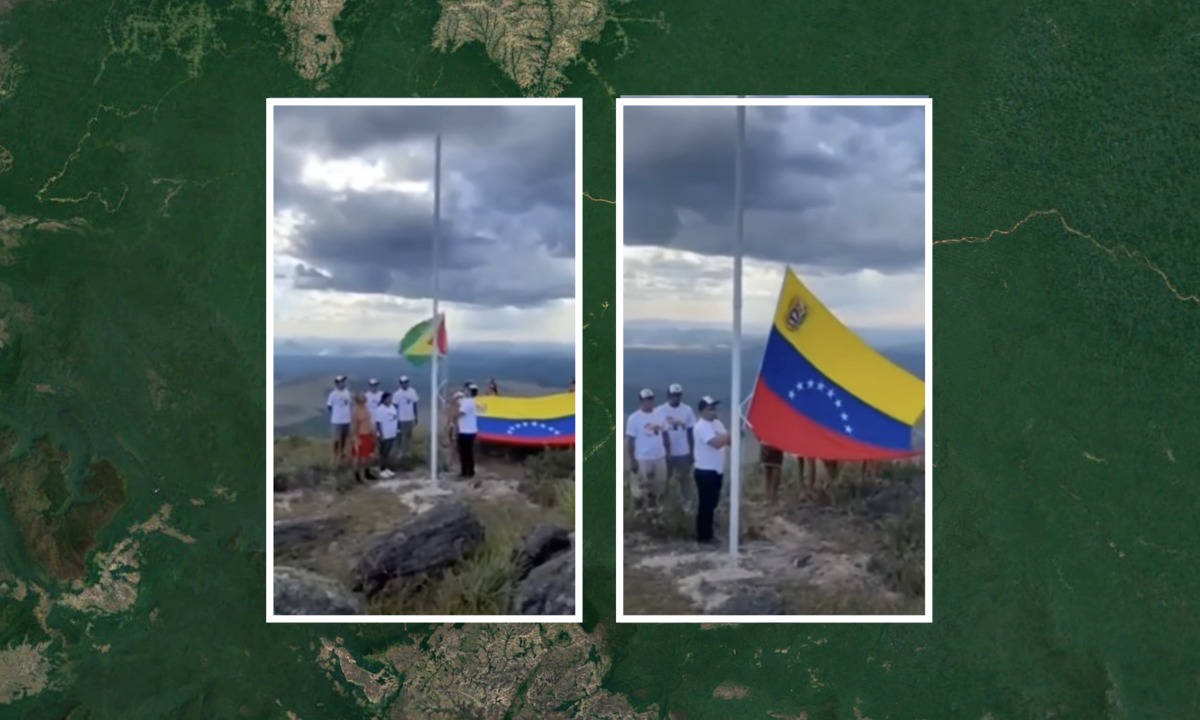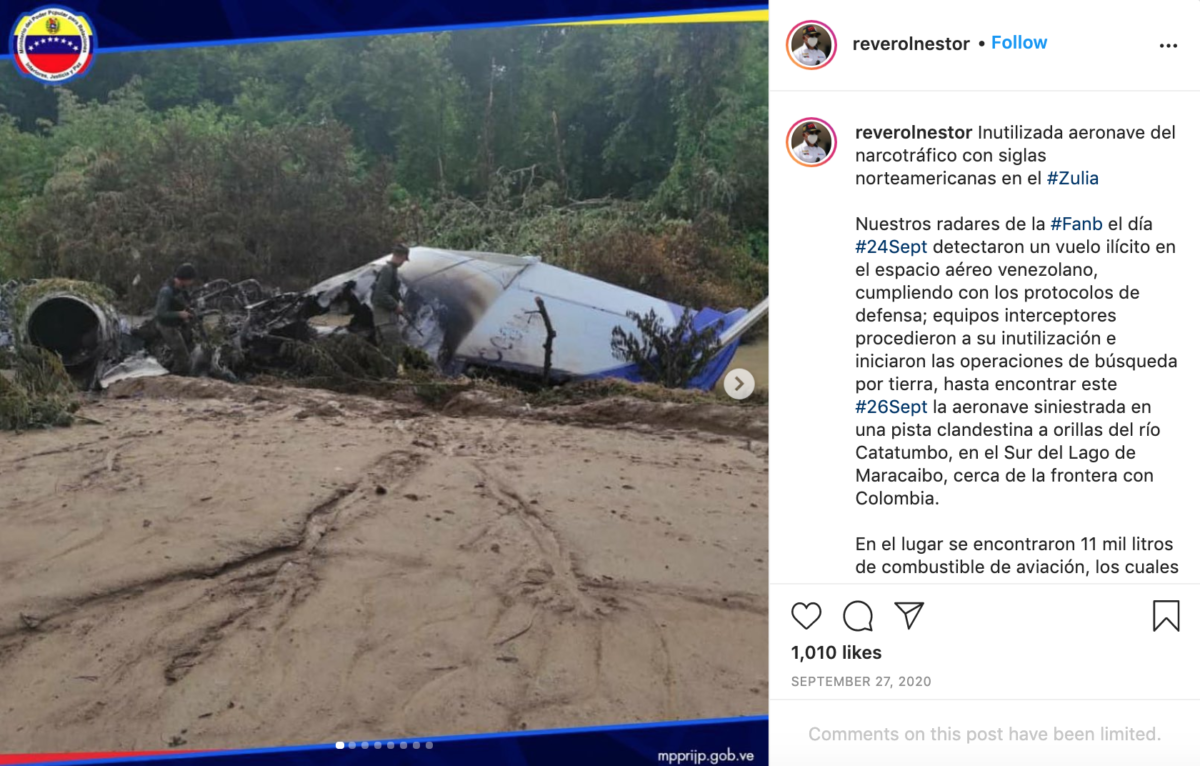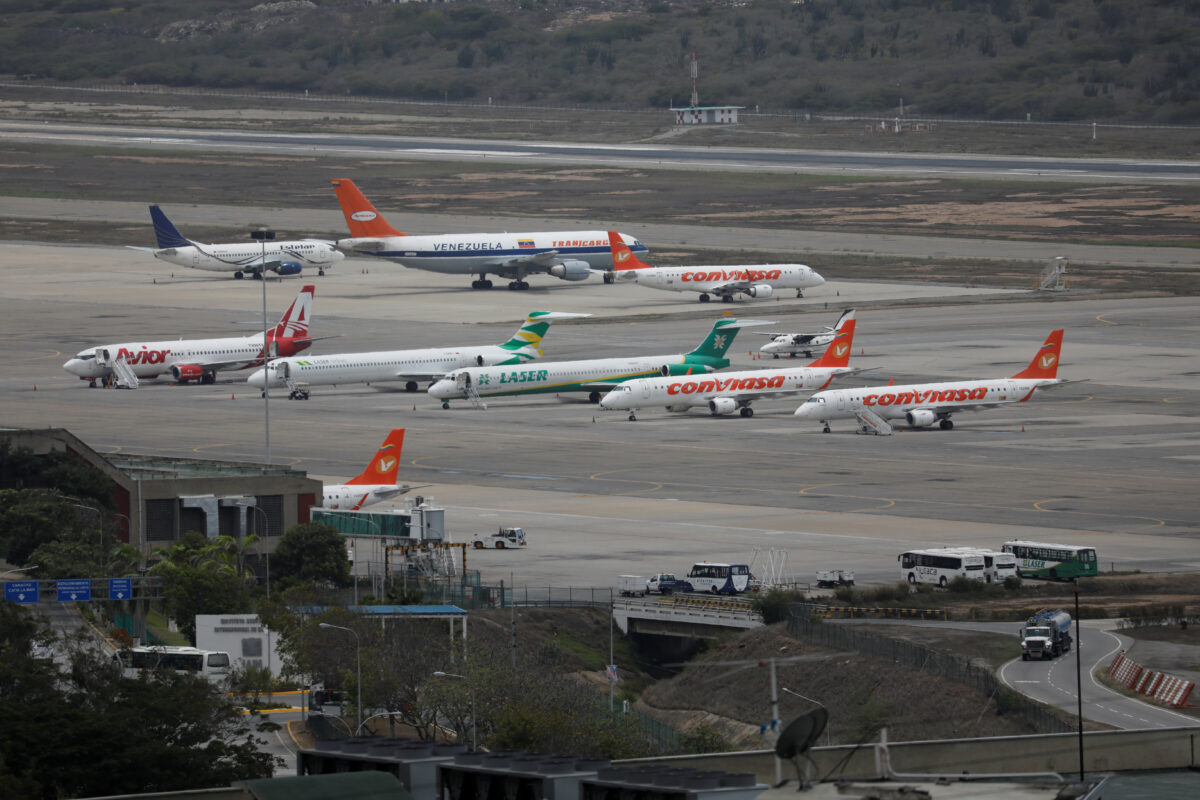Identifying Aircraft in the Canaima Operation in Venezuela
All times are shown as UTC-4 local time.
On December 8, 2018, reports appeared on Twitter claiming that YV2030—an airplane used by President Nicolás Maduro’s nephews during their failed drug trafficking career—was taking part in a military operation in Canaima, a remote town located in Venezuela’s Bolivar state. The news came via a journalist named Germán Dam, who claimed that officers with the Dirección General de Contrainteligencia Militar [General Directorate for Military Counterintelligence] (DGCIM) were conducting an operation “targeting illegal mining” in the resource-rich region.
Dam tweeted about the event throughout the day, providing an important link between developments in Canaima and the rest of the world. Accessible only by air, Canaima is frequented by tourists given its proximity to Angel Falls, a natural wonder of the world. The area—which is close to what the Venezuelan government has called the Arco Minero— has also become synonymous with illegal mining and violence in recent years.
Quoting a source in Canaima, Dam said that the DGCIM officers arrived by air and “were armed to the teeth”, and that two local Pemon indigenous guides and two officers had been injured in the operation. The two injured guides were airlifted to a hospital located in Ciudad Bolivar, some 220 kilometers to the north. There, 21-year-old named Charlie Peñaloza died of gunshot injuries later that day.
At 8:24 PM, Dam tweeted a screenshot of a WhatsApp conversation he was allegedly having with someone in Canaima. In the conversation, the source says that one of the airplanes that flew the officers to the town bore the registration number YV2030. The source tells Dam that the officers were staying at a hotel called Kavax (likely a misspelling of “Kavac”, the name of an excursion company in Canaima), and that they had hired guides to take them to Angel Falls. Below, Dam’s tweet and the WhatsApp screenshot that he posted:
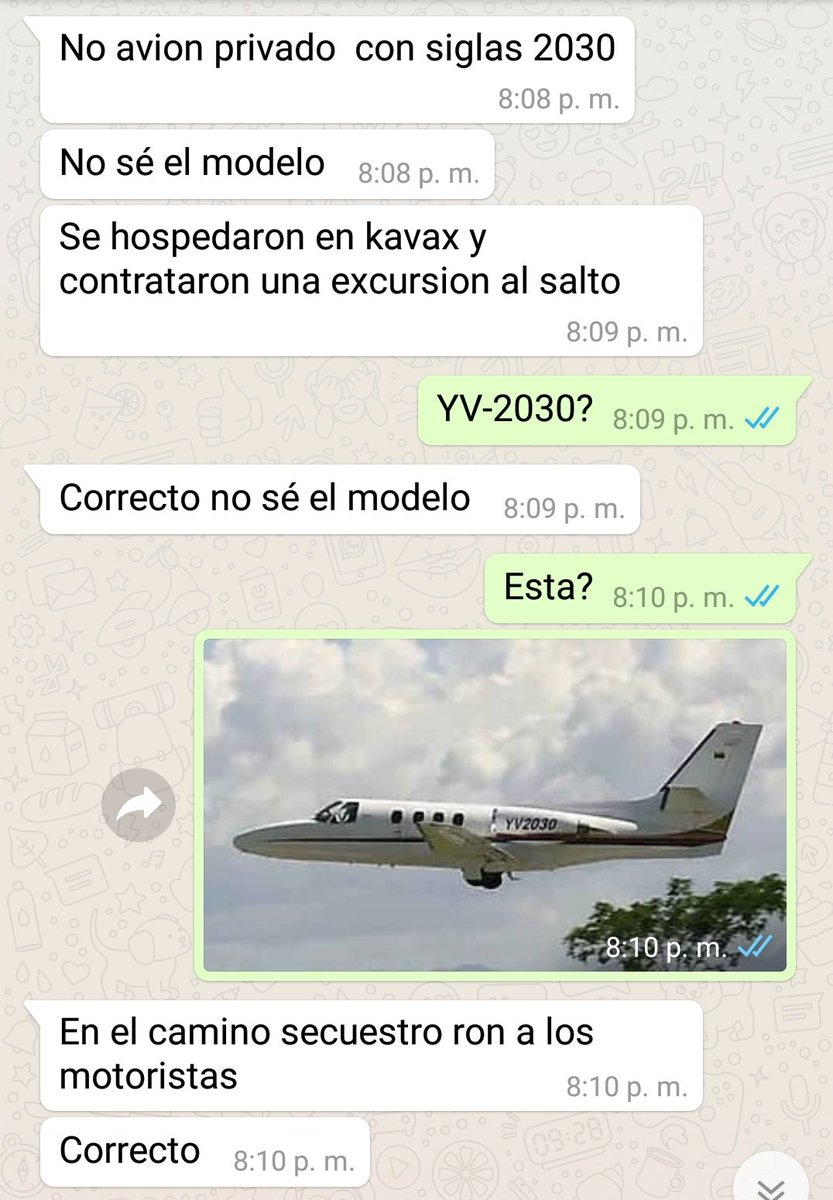
The tweet to which the image was attached is archived here.
YV2030 made national headlines on November 10, 2015. That day, two of President Maduro’s nephews—Efrain and Francisco Flores—used YV2030 to fly to Haiti to set up a drug trafficking operation. The pair were arrested on the island by agents from the United States Drug Enforcement Administration (DEA), and are currently serving 18 years in prison after having been found guilty of drug trafficking charges.
At 12:35 PM on December 9, Dam posted another tweet, this one allegedly showing other aircraft that the officers used to fly to the town. The tweet contains four images: three of helicopters, and one of YV2030.
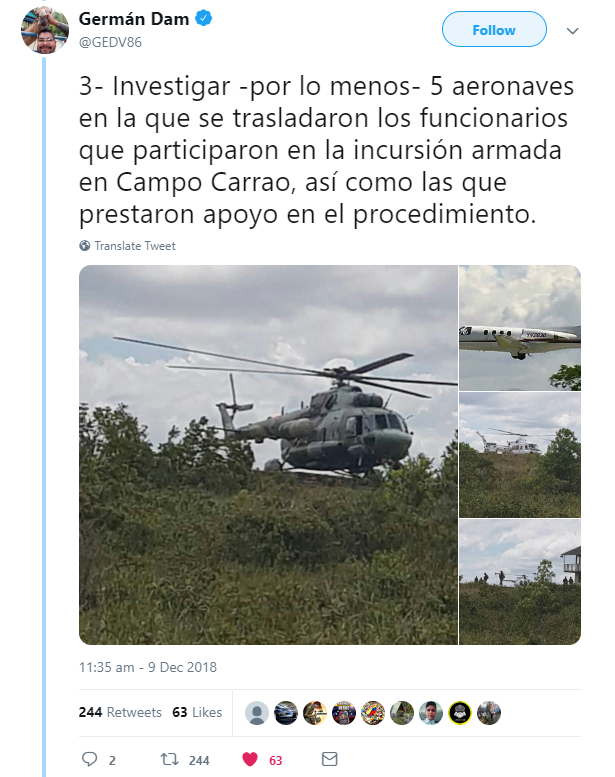
This tweet is archived here.
News of YV2030’s alleged involvement in the Canaima operation quickly spread through social media given the airplane’s infamous past. Reports YV2030’s appearance were featured on national and international media. The news was also tweeted by National Assembly deputy Americo De Grazia, a nationally-recognized politician who represents Bolivar state:
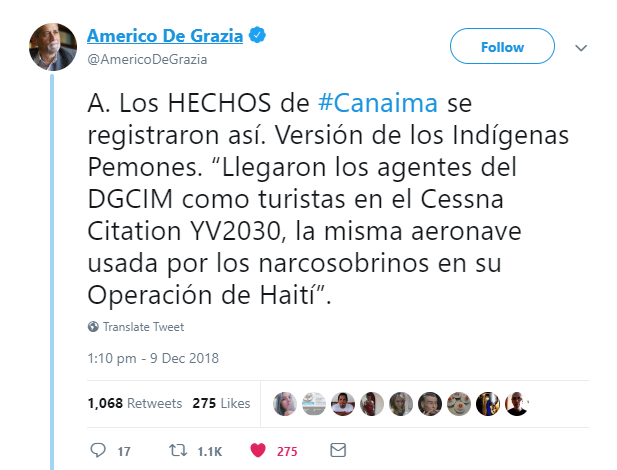
This tweet is archived here.
Using open source information, this article will cast doubt on the reports that YV2030 took part in the Canaima operation and show that the three helicopters shown in Dam’s tweet above did.
The Canaima Operation — What Happened?
Whether or not YV2030 took part in the Canaima operation, several facts are clear.
On the morning of December 8 2018, a group of approximately ten officers left the town of Canaima and traveled in the direction of Angel Falls disguised as tourists. They had arrived in the town the day before aboard civilian aircraft. As tourists often do, they hired boats to take them up the Carrao river to Angel Falls. Once they reached the vicinity of Orquidea Island, the officers revealed themselves and forced their guides to take them further up the river to a mine in an area called Camp Arenal, seen here in a tourist map of the region.
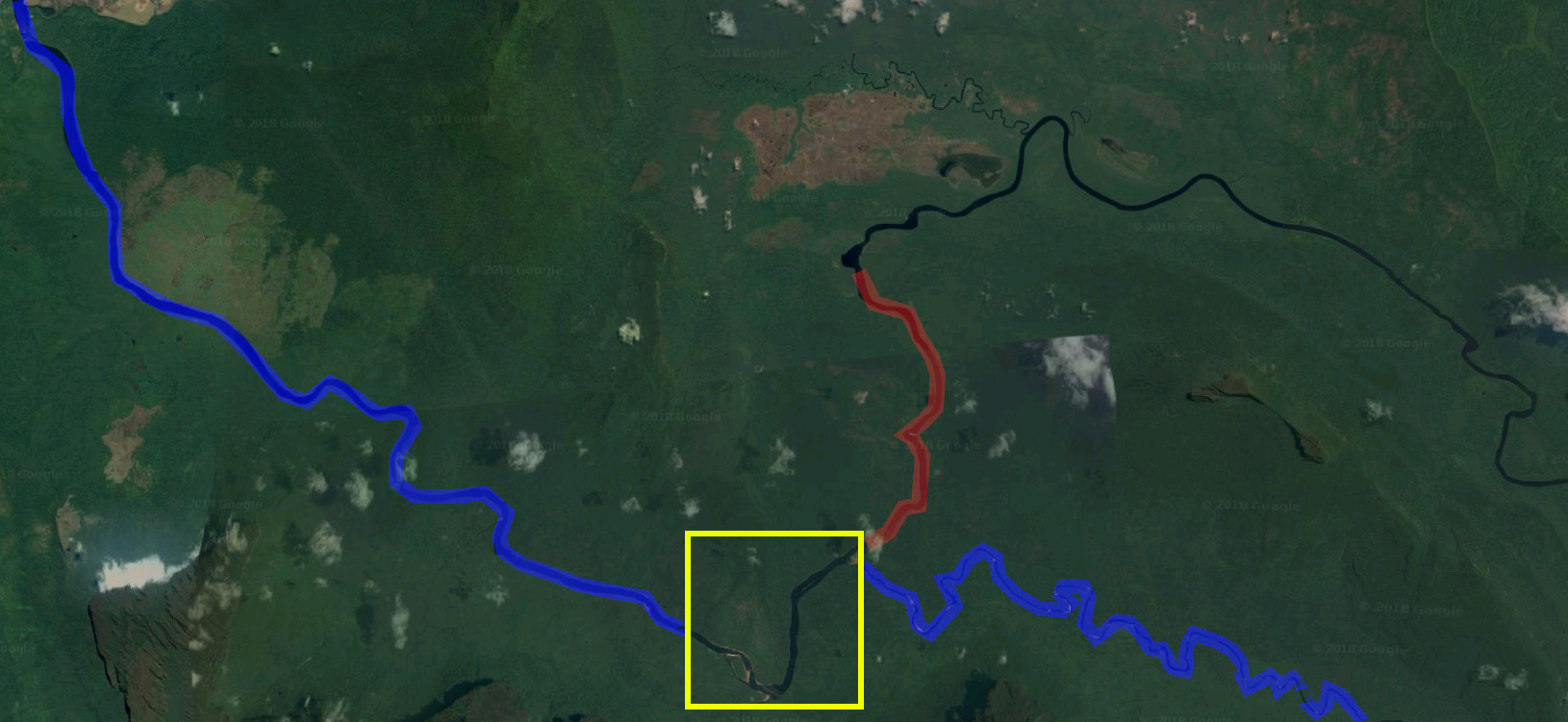
The river route that tourists take from Canaima (left of the image) to Angel Falls (right of the image) is in blue. The yellow box is the approximate area where the officers first revealed themselves to their guides and demanded that they take a detour, in red, to the Camp Arenal area further upstream (Image: Google Maps).
The moment when the officers first confronted their guides was caught on video by a witness. In the video, men can be heard shouting while sporadic gunfire rings out. While the visual clues in the video are few, they confirm the facts as reported by witnesses that the officers first confronted their guides aboard boats on the Carrao river. Below, the video:
#11Dic La masacre en #Canaima grabada por un pemón en #CampoCarrao, en el que se pueden escuchar las ráfagas de disparos que propinaron funcionarios del #Dgcim / Video cortesía @GEDV86 pic.twitter.com/EiGPhVB2NS
— CaraotaDigital (@CaraotaDigital) December 11, 2018
The two groups disengaged, with the guides returning to Canaima with three injured, including the Peñaloza brothers. In the video below, one of the injured men is taken into the Canaima clinic:
Según habitantes de #Canaima serían al menos 4 las personas heridas. Dos ya están en el hospital Ruiz y Páez,Ciudad #Bolívar y otros dos permanen en la Capitania detenidos por averiguaciones.
Cortesía?#8Dic pic.twitter.com/w5UTWELBRL
— Pableysa Ostos (@PableOstos) December 8, 2018
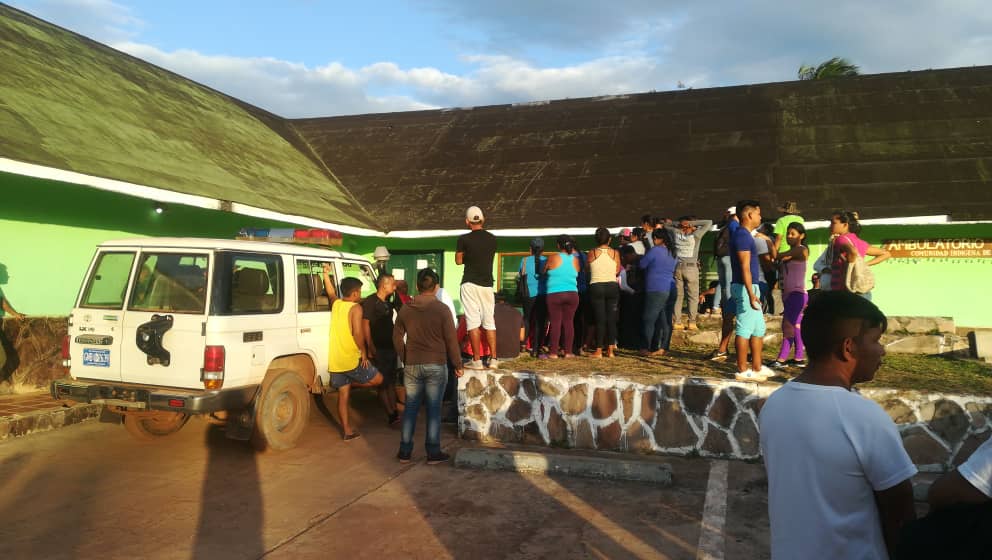
Residents wait outside of the building that housed the injured. The sign on the building reads “ambulatorio”, which means clinic. Source: @PableOstos
A survey of Canaima through satellite images shows that the building’s distinctive “L” shape, black roof, and open space on its front are unique in the town, allowing for the geolocation of the structure.
Due to the seriousness of their injuries, the Peñaloza brothers were airlifted to a hospital in Ciudad Bolivar, the closest urban area to Canaima. In the video below, a woman tells the injured man on the back of the truck, “Be strong, Carlos!” as he is loaded onto the airplane, suggesting that the injured man is Carlos Peñaloza:
?⚠️ ATENCIÓN ⚠️? Al menos dos indígenas pemones resultaron heridos tras incursión militar en una mina en el Parque Nacional Canaima.“S.O.S #PNCanaima convertido en tierra de guerra. Tenemos tiempo diciendo que es más fácil hoy hacer actividad minera en el Salto Ángel pic.twitter.com/av2ie4QTdR
— venezuelaenSC (@venezolanosenSC) December 9, 2018
The video was filmed at the Canaima airport, located here.
But the injured were not the only ones to return to Canaima: one of the officers was captured and brought back to town for questioning. The prisoner was disarmed and taken into a makeshift holding cell located in the clinic. There, he spoke to the crowd outside his window, and to a man with a Spanish accent whom he refers to as “padre,” suggesting that he is a priest. The prisoner refused to identify himself or say who he was with.
While the captured man refuses to reveal his identity, one exchange suggests that he was a on a mission against illegal mining in the area. At the end of this video, the following exchange takes place:
Woman: Who are you people? Who are you people?
Prisoner: The time will come when we will say who we are, ma’am. You shouldn’t be doing what you’re doing.
Woman: And what is that?
Prisoner: [Unintelligible] mining.
While in captivity, the same officer was placed on a chair in an open area in front of the clinic, and a crowd gathered around him.
In the video below, the Spanish man argues with people in the crowd that their prisoner should not be harmed, and that he should be placed “in a closed area” to guarantee his safety. The crowd forms a ring around the prisoner, and a man in a blue shirt—whom the crowd refers to as “the Captain”— emerges to interrogate the man. The Captain approaches the man and asks, “Who are you?” When the man refuses to answer, the Captain slaps him.
The Three Helicopters
At 10:50 PM on December 8, Dam tweeted an image of a helicopter, saying that it had arrived along with two others “in [the] afternoon” as part of the operation. A crowd gathered near the landing site, and at least two witnesses filmed footage at the scene. In the video below, a crowd gathers near the helicopters, and the man recording claims that the officers that disembarked from the aircraft shot them with tear gas:
2. S.O.S #PNCanaima convertido en tierra de guerra. Tenemos tiempo diciendo que es más fácil hoy hacer actividad minera en el Salto Ángel, que instalar un hotel. En este momento se registra enfrentamientos entre #Indigenas y GNB. pic.twitter.com/dEw46qYYle
— Americo De Grazia (@AmericoDeGrazia) December 8, 2018
Note the tower towards the end of the video, along with the faint outlines of the helicopters.
Someone in the crowd also managed to take pictures of the three helicopters:
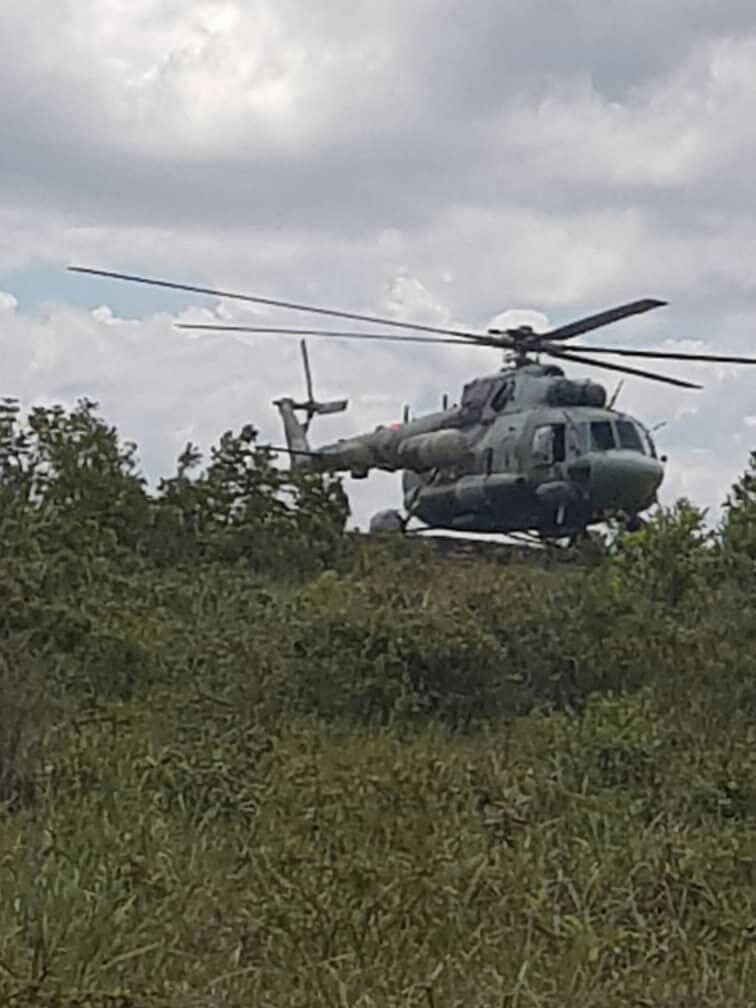
The helicopter in this image is likely a Mil Mi-17V-5. Note the identical configuration of its tanks in this reference image. Source: @GEDV86
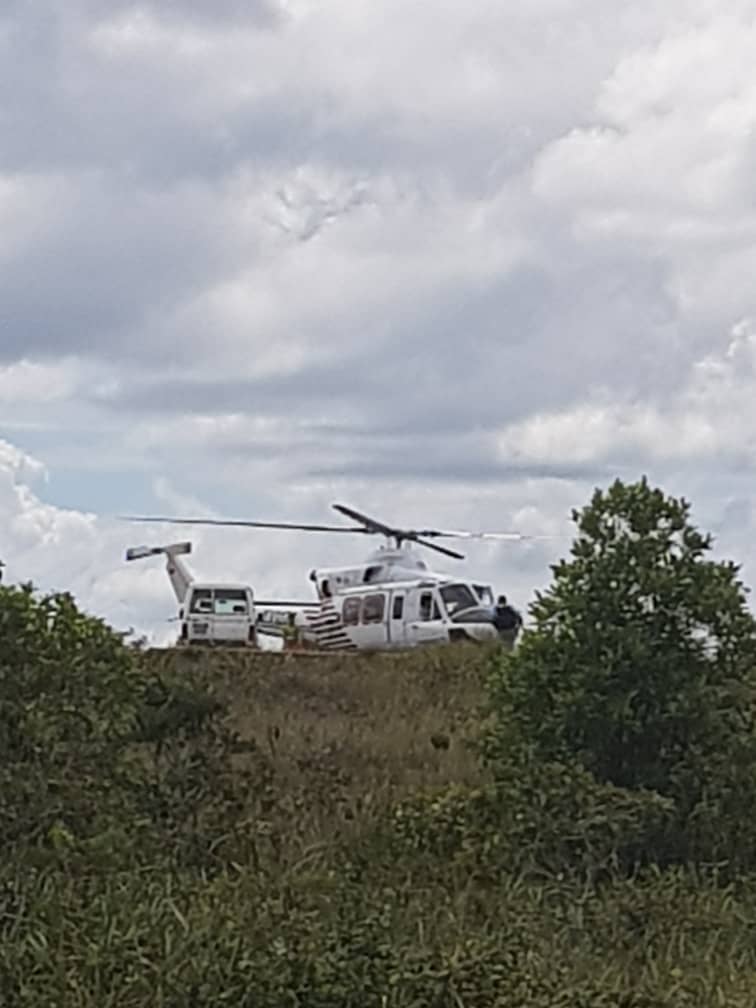
The helicopter in this image is likely a Bell 412, like the one seen in flight in this video. Source: @GEDV86
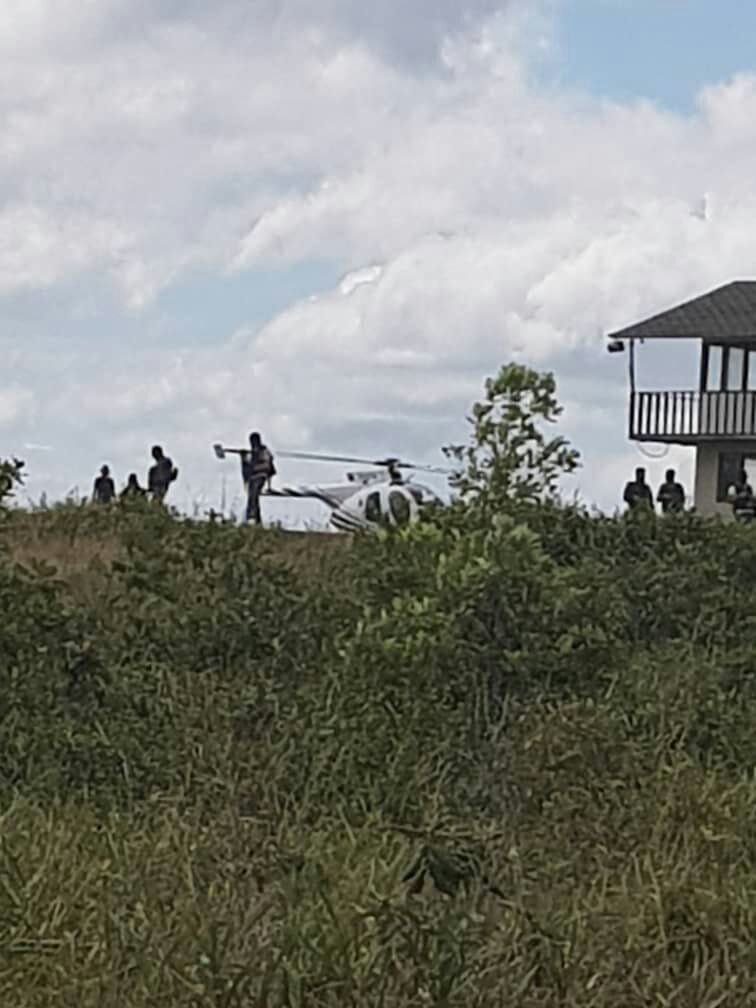
The helicopter in this image is likely a MD500E, like the one in this video. Note that the men appear to be in uniform, and that their faces are covered. Source: @GEDV86
Another person in the crowd also recorded a video at the same time, which you can see below. Note the tower on the right side of the screen towards the end of the video. Note that the three helicopters appear towards the end of the video:
The layout of the road—which is shaped like a cross—along with the tower visible in the video allow us to geolocate the spot where the helicopters landed: a trio of helipads located northwest of the Canaima Airport.
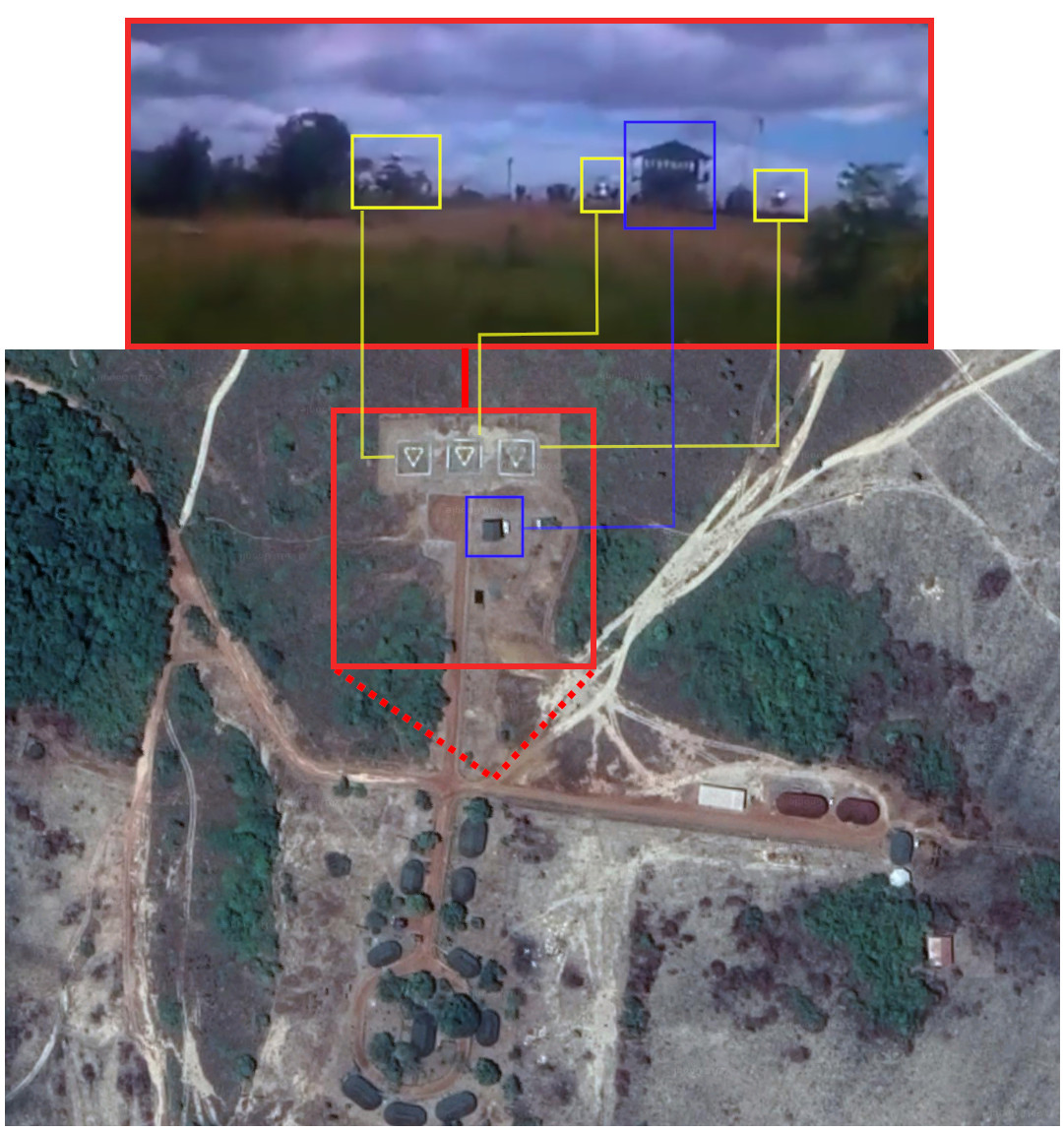
The helipads, along with a reference image from the video above, with the three helicopters and the tower highlighted for clarity (Image: Google Maps).
By the end of the day, Charlie Peñaloza lay dead in the Ruiz y Páez Hospital in Ciudad Bolivar. And from the capital of Caracas, no acknowledgement of the operation came.
Was YV2030 in Canaima On December 8, 2018?
Two facts make it unlikely that the airplane that President Maduro’s nephews used in their failed drug trafficking business in 2015 played a role in the Canaima operation.
First, there was an early conflation between an old reference image of YV2030 with what was thought to be a current image of the airplane in Canaima on December 8. In Dam’s 8:24 PM tweet on December 8, one of the participants in the chat—from the context of the chat, Dam himself—sends the other an image of YV2030. A reverse image search on Yandex reveals this to be an old image of the airplane, as the exact same picture appeared in several news articles covering the Flores’ case dating back to 2015.
Below, the same image of YV2030 as it appeared in an article from Aporrea, a Venezuelan news website, on November 25, 2016:
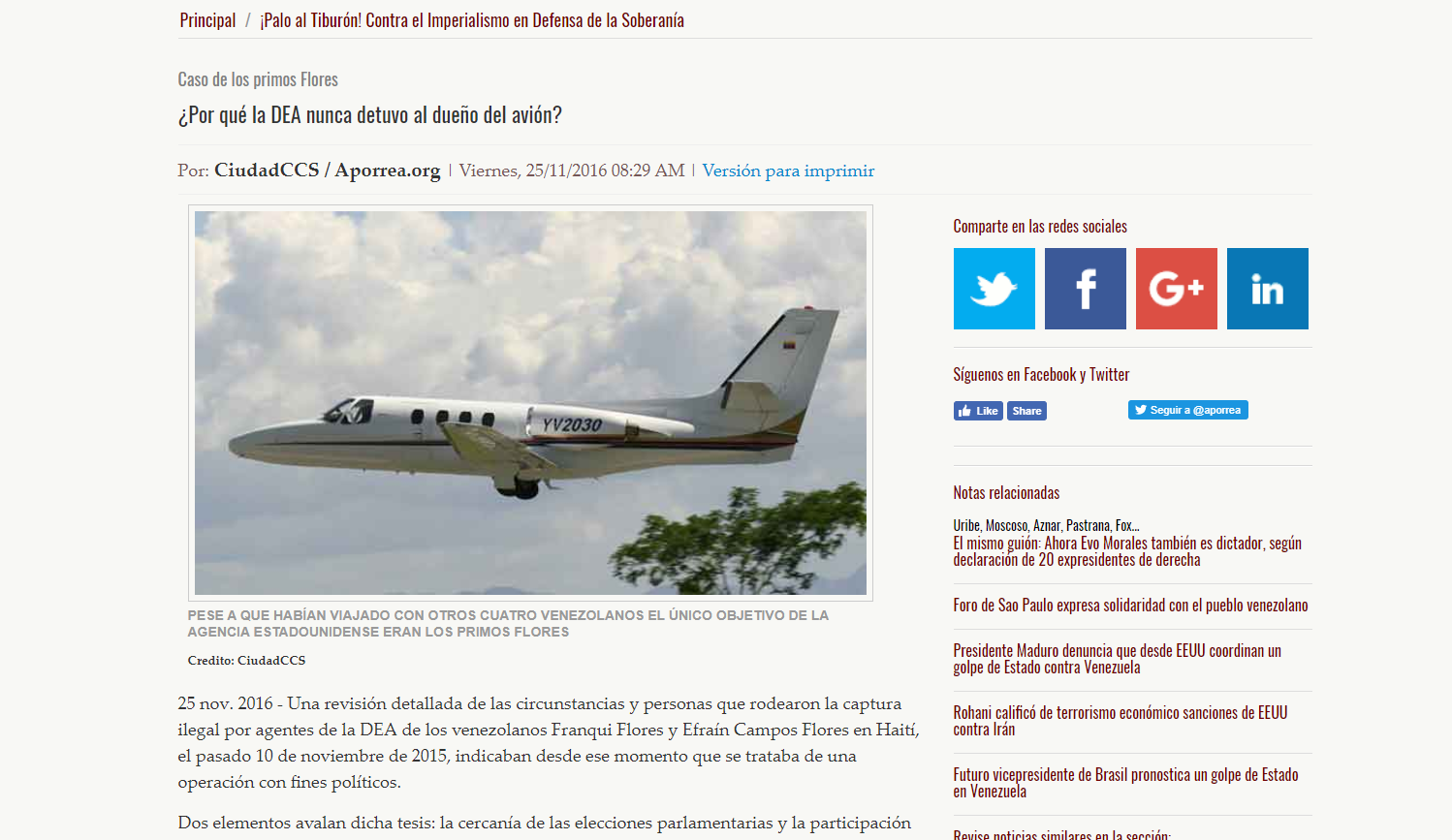
The image of YV2030 that Dam shared on December 8 was the same used in an article dating back to November 25, 2016.
The suggestion that YV2030 was photographed in Canaima on December 8 was strengthened with Dam’s 12:35 PM tweet on December 9, which showed a collage of four images: three helicopters and YV2030. While the three helicopters were the ones that were filmed in the heliport northwest of the Canaima Airport on December 8, the image of YV2030 is the same reference image that has existed online since at least 2015. A quick glance at the tweet, however, might give the wrong impression that all four aircraft were photographed together in Canaima on December 8.
Second, news of the event from the subsequent days make mention of other aircraft, but not YV2030. A journalist named Pableysa Ostos tweeted on December 9 at 12:19 PM that a meeting of local indigenous leaders had identified the following aircraft registration numbers involved in the operation: “YV2437, YV3087, YV2343, YV33322, and YV3087 [sic]”. Below, Ostos’ tweet:
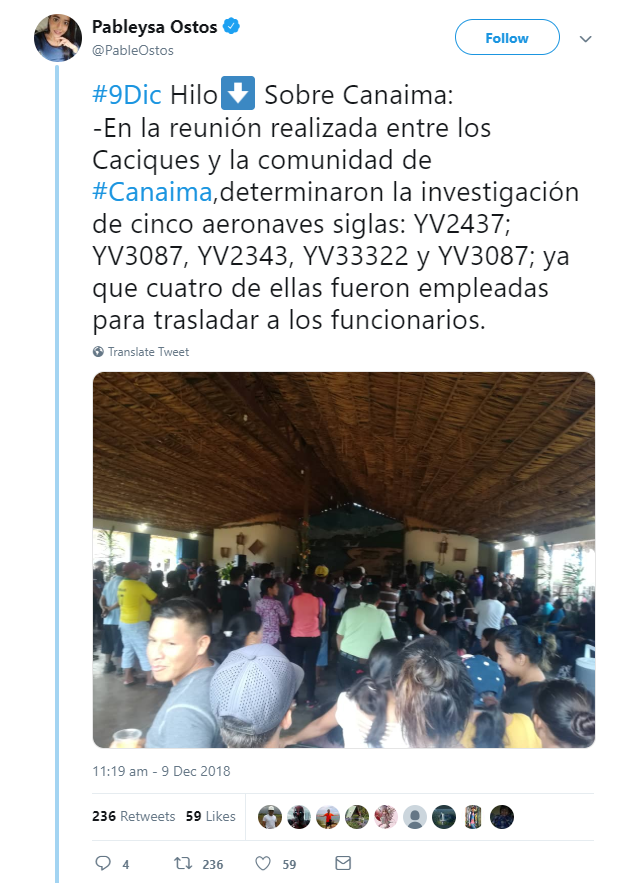
Ostos’ tweet listing the aircraft suspected of having taken part in the Canaima operation according to local leaders. The tweet is archived here.
Ostos’ tweet contains an error: YV3087 is listed twice. Given the wording of her tweet, it is not clear if Ostos meant to write that the leaders were “investigating five airplanes” because she wrote a fifth registration number erroneously, or that the leaders had zeroed in on four aircraft “because four of them were used to transport the officers”.
Despite this ambiguity, notably absent from Ostos’ tweet is any mention of YV2030. Due to the high-profile nature of the airplane and its connection to President Maduro, it is likely that if the indigenous leaders had in fact mentioned YV2030 at their meeting, then Ostos would have done so as well either in the tweet above or in subsequent ones. For this reason, it is likely that the leaders did not name YV2030 at their meeting.
Given the early confusion between the YV2030 reference image and images of the aircraft that were photographed in Canaima on December 8, and the airplane’s apparent absence from the indigenous leaders’ meeting on December 9, it is likely that YV2030 did not take part in the military operation in Canaima on December 8, 2018.
It is important to stress that I am not attributing malicious intent to Germán Dam for reporting that YV2030 took part in this operation. It is entirely possible that Dam’s source in Canaima reported the information to him completely in good faith, and that Dam shared it in the same way.
Breaking news move fast, and the information that trickles out communities under stress can sometimes be incorrect. The fact that YV2030 likely did not play a role in this event does not take away from the other facts of this case.
The Mafia, the Liars, and Violence in the Arco Minero
After three days of complete silence on the matter, Minister of Defense Vladimir Padrino López formally acknowledged in a press conference that there had been a “confrontation” during a security operation in Canaima on December 8, and categorized the death of Charlie Peñaloza as unfortunate. López went on to say that the Pemon community have become the victims of “mafias associated with the Venezuelan political opposition,” whom he blamed for illegal mining in the area.
Canaima’s Pemon community responded to López in a video statement shortly after his press conference. The woman reading the statement calls López a “coward for denying the role of the Venezuelan government” in the violence and calls him “cynical… and a liar.” The woman then says:
“The Minister of Defense says that the ones responsible for the death of our brother are the mafias, and that the indigenous people are its victims. Do you mean to say that this military operation [was carried out by] the mafia, and that the indigenous people are its victims? The truth is that you, minister, are the mafia.”
So far this year, at least 12 indigenous people have been killed in resource-related violence in the Arco Minero. In mid-October of this year, at least 16 people were killed in the Tumeremo region of Bolivar state—some 200 kilometers northeast of Canaima—in a fight over mining territory that allegedly included the Ejército de Liberación Nacional [National Liberation Army] (ELN), a Colombian paramilitary group. So long as generalized corruption continues to afflict the Venezuelan state, it is likely that the residents of this area will continue to be victimized by actors—including state authorities—drawn to the region by greed.
